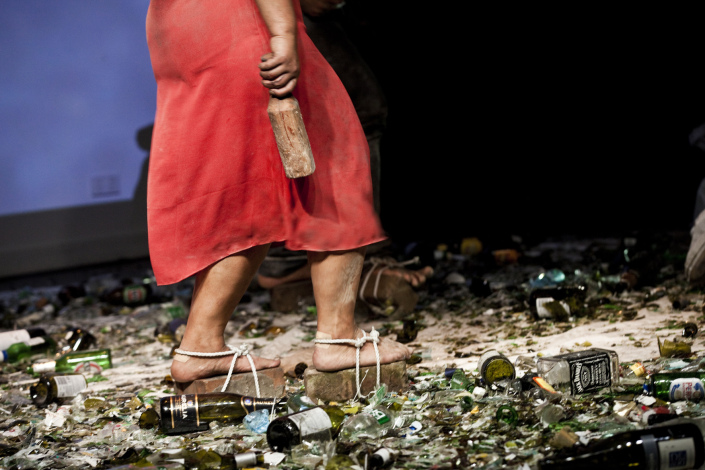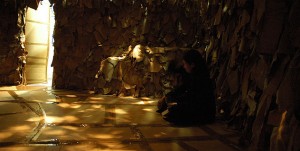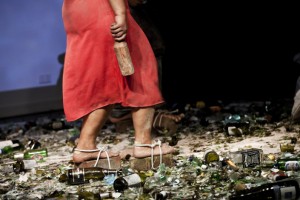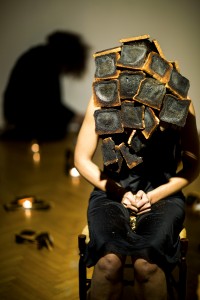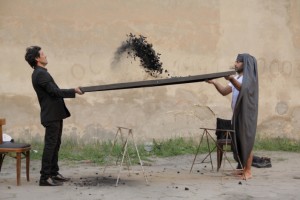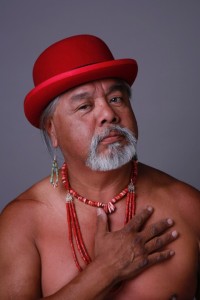Cardboard homes, broken bottles and burnt toast – Rebecca Nice goes to SACRED:Homelands, a festival of international installation and performance works.
SACRED:Homelands saw London treated to a five-day festival of international works reflecting on home and displacement in contemporary society. It delivered a loaded and poignant critique that sought to engage with current social and political issues – and linked emotional crises – around notions of ‘home’. It was produced by Francis Alexander, building on the SACRED seasons of live art at Chelsea Theatre 2006-2015; and was curated by Nikki Milican, former artistic director of New Territories (Scotland) and the esteemed and much-missed National Review of Live Art. ‘We need a place for healing and community in times of grave injustice and inequality,’ says Milican. ‘The week is defined by UK premieres by renowned international artists telling of lost communities, languages and culture; a search for homeland.’
SACRED:Homelands is housed for its duration at Toynbee Studios, which hosts a series of works that form constructions and deconstructions of both physical and conceptual homes. They are spread across four floors, with a series of durational pieces allowing for wanderers to amble in and out of mysterious, stark or cosy worlds. Built into the programme are artist-led discussions, which foster a culture of debate that emanates from each studio and out into the bar, as the festival audience shifts into a community of activists for the evening.
In Parabox, Josephine Garcia Jowett (Philippines/New Zealand) spends a week at Toynbee Studios building a cardboard shed. Through three durational performances totalling twelve hours of creation, viewers are able to encounter the artist in her paper home as she revisits the trauma of losing her family house and sets on a new journey to eventually rebuild it for her deceased mother. On Friday night I discover the ramshackle box with a cutaway entrance, back-lit by hanging bulbs, and am enticed inside to hide in the glowing den. Conversations immediately strike up with my fellow den dwellers who marvel at how comfortable they feel here. But whilst we experience a sense of safety and warmth, a sense of guilt and uneasiness emerges as we are invited to contemplate what it is like to lose your home and to rely on something so transient for safety – Josephine Jowett watched her house burn to the ground and lost her temporary cardboard shelter to a typhoon.. The theatricality of the cardboard box placed in a studio provides an artistic home for the real meat of the piece. It facilitates Jowett in sharing her story of loss and corruption and it is only then that the complexities of the work begin to emerge. Parabox is strongest in discussion and interaction with Jowett herself who is still navigating a journey from the Philippines to New Zealand to the UK, rebuilding a home in homage to her mother.
Meanwhile, Latai Taumoepeau, from Tonga/Australia, is creating her own methodical, one-woman stampede in a studio covered with a bed of glass. Broken bottles and shining shards of blue and green hues form a dangerous terrain that bleeds into the shining cityscape that extends the space through its panoramic windows. Satisfying staccato crunches, shatters and tinkles that sound like cracking ice, falling snowflakes, and fairy chatter. This evocative soundscape is created by Taumoepeau as she works to break the glass beneath her feet, which are strapped to heavy bricks. She regularly bends over to smash more glass with a heavy sort of baton, creating images that reference Jean-Francois Millet’s 18th century painting The Gleaners. Finding the heroic in the every toil of the working classes post French Revolution, Taumoepeau, like Millet seeks to highlight the tension between the privileged and lower classes, here using her body as a landscape. Her dual body is one of the privileged elite and a body politic of the underclasses which she frankly discusses in conversation with Nelson Fernandez on Saturday night. Taumoepeau wrestles with identity as she claims to make work ‘about them but not for them’.
There is a violence in the heavy plods and stamps of the artist and a delicacy in the evocative sounds that continue to emanate from the disintegrating material. As specks of blood on her calves turn into red lines and her breathing gets faster the toil, work and effort of the task is highlighted. The magnified silhouettes behind evoke a great monochrome being stamping on the planet, flattening it to dust. A shadowy team of two, then four is multiplied further by her reflections in the windows. The colourfully lit landscape now takes a battering from the opaque army of stamping figures. A pile of dust in one corner of the floor hints at the transformatory possibilities of the work. How the function of the material might change as a result offers potential outcomes that would add a further dimension to its dialogue.
Meanwhile, artists Zierle & Carter (UK/Germany) present a wonderfully macabre and fantastical world in durational work Following the Crow’s Heart. Smells of toasting bread waft along the corridor as visitors are warned of an excess of gluten in the room they are about to enter. Tonight’s installation builds on Thursday’s performance Charred to the Bone – Where is Home now?, in which two performers sit isolated from one another but connected by a trail of burnt toast that forms a bridge between them. Audience members are invited to choose and place objects to form mini toast shrines within the space. Their choices are governed by thoughts of home and what or how that might be. This makes for a transformative piece culminating in a new environment with a sense of ownership and identity connected with its participants.
I enter on Friday night into a warm, tasty, inviting environment and it is only as I look closer that the scattered micro-installations reveal a tension between beauty and something more sinister. Toast circles, candlelit shrines, piles of white bones, and glowing red apples evoke traces of spell-making, alchemy and fairytale pursuits. The room is in constant flux as Zierle and Carter continue to perform strange rituals with the objects, leaving circular scuffs on the floor, puddles of water, and collapsed or melted bird trifles. Motifs of bodiless feet, and headless birds emerge in an image of stifled communication or disconnection which jars with the room’s homely atmosphere. Hooves next to bones and shoes filled with hair give a sense of grounding in space and place whilst igniting a sense of missing something. As Alexandra Zierle speaks through a microphone with her head immersed in water barriers in communication through facial expression and language increase the displacement of people in the room. Audience members sit around a table covered in objects for rituals and form a circle around the performers, they become part of this homage to the notions and complexities of home by their interaction, placement and displacement within the space. Viewers need to spend a long time absorbing this work in order to witness the performative elements and draw interpretations from them. The choices behind the object play and compositions allow for an interesting and unexpected contemplation on human behaviour.
The work seen the following day was less inspiring, although with some highlights. Saturday’s evening performances included This Kasheer/Taste Kosur, in which a charismatic Inder Salim (from Kashmir) serves up paella to a full and bustling studio of people deep in conversation. The studio is scattered with saucepans, ladders, planks of wood, and a megaphone. Salim is serving up freshly prepared food wearing an open gown with nothing underneath. He cuts portrait photographs from his gown and hands them to diners to eat the food from. His multidisciplinary work seeks to use art as a form of activism.
James Luna presented a solo work, Native Stories: The Ground Beneath Us, which was less performative than other works seen, the artist (a Pooyukitchchum/Ipai native American) in storyteller mode, exploring ‘stories of fantasy futuristic tales, personal antidotes, country music legend Merle Haggard and the spirits within all of us, all said with irony, humour and hope.’
Ali AL-Fatlawi and Wathiq Al-Ameri, from Iraq/Switzerland, close the festival with Urnamo which uses everyday objects and tasks to physically exhaust the performers by inhibiting them with bungee rope. One fills his shirt with ping-pong balls and gradually travels, tightening the rope that joins him to the second seated performer. BANK HACKING SOFTWARE BANK HACKING TOOLS BANK ACCOUNT HACKING SOFTWARE HACKED BANK ACCOUNT DETAILS HOW TO HACK A BANK ACCOUNT BANK HACKING FORUM RUSSIAN HACKERS FORUM BANK TRANSFER HACKER LEGIT BANK TRANSFER HACKER BANK TRANSFER HACKERS FORUM BANK HACK ADD UNLIMITED MONEY GET OVER $100,000 USD MONTHLY THROUGH RUSSIAN HACKERS AND ATM CLONED CARDS, CONTACT US TODAY TO RECEIVE MONEY TRANSFER VIA WWW.BANKTRANSFERHACKERS.SU BANK LOANS BANK LOANS NEAR ME BANK LOANS FOR BAD CREDIT STARTUP BUSINESS LOANS BANK LOANS ONLINE BANK LOANS CHASE BANK LOANS FOR STUDENTS BANK LOANS FOR CARS BANK LOANS INTEREST RATE BANK LOANS FOR HOMES BANK LOANS CORONAVIRUS BANK LOANS FOR BUSINESSES BANK LOANS FOR STARTUPS BANK LOANS FOR START UP BUSINESS STUDENT BANK LOANS As he pulls strips of meat from a large joint and tries to stick it on his face, he is continually pulled off his chair by the rope. Altering the function of everyday objects and commenting and inhibiting tasks the work attempts to comment on war, border crossings and attitudes to Iraqi culture, but their message is at risk of becoming too obscure and abstracted to fully grasp.
The culture of dialogue continued throughout Saturday with Latai Tauamoepeau and Josephine Jowett in conversation with Nelson Fernandez. They frankly and emotively discuss family legacy, heritage and the struggle of making a home in a society tied by class and bureaucracy. SACRED:Homelands is at its best in conversation over the beautiful installations. It is here that voices are articulated, formed and heard, and here that pressing issues are ruminated upon: immigration, family, refuge, home and provocation.
SACRED:Homelands Festival 2016 ran 23–27 November at Toynbee Studios, London. www.artsadmin.co.uk
Further details on the festival programme and artists at www.sacredhomelandsfestival.wordpress.com
Rebecca Nice attended the festival on Friday 25 & Saturday 26 November 2016.

